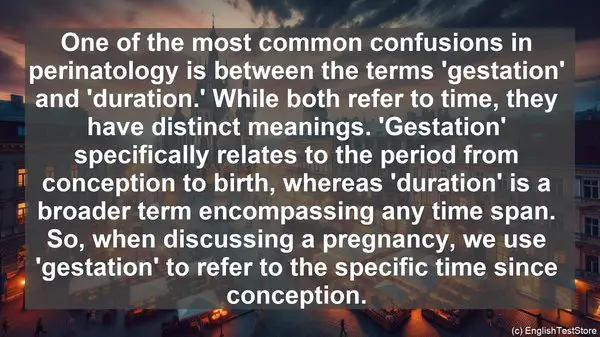Introduction
Welcome to today’s perinatology class. In the field of perinatology, there are several words that are commonly confused. Understanding the correct usage of these terms is crucial for effective communication and patient care. In this lesson, we will explore the top 10 words that often cause confusion. So, let’s dive in!
1. Gestation vs. Duration
One of the most common confusions in perinatology is between the terms ‘gestation’ and ‘duration.’ While both refer to time, they have distinct meanings. ‘Gestation’ specifically relates to the period from conception to birth, whereas ‘duration’ is a broader term encompassing any time span. So, when discussing a pregnancy, we use ‘gestation’ to refer to the specific time since conception.
2. Neonate vs. Newborn
The terms ‘neonate’ and ‘newborn’ are often used interchangeably, but they have subtle differences. A ‘neonate’ refers to a baby within the first 28 days of life, whereas a ‘newborn’ is a more general term for a recently born baby. So, while all neonates are newborns, not all newborns are neonates.

3. Preterm vs. Premature
Another pair of words that can cause confusion is ‘preterm’ and ‘premature.’ ‘Preterm’ refers to a baby born before completing 37 weeks of gestation, whereas ‘premature’ generally means a baby born before reaching the full term. So, while all preterm babies are premature, not all premature babies are preterm.
4. Fetus vs. Embryo
During the early stages of pregnancy, the developing baby is referred to as an ’embryo.’ After about 8 weeks, it is called a ‘fetus.’ So, the term ‘fetus’ is used for a more developed stage of pregnancy, while ’embryo’ is used for the earlier stage.
5. Contraction vs. Contradiction
In perinatology, the term ‘contraction’ is commonly used to refer to the rhythmic tightening of the uterus during labor. However, it is often confused with ‘contradiction,’ which means a statement or action that goes against another. So, while ‘contraction’ is related to labor, ‘contradiction’ is a term used in a different context.
6. Placenta vs. Placenta Previa
The ‘placenta’ is an essential organ during pregnancy that provides oxygen and nutrients to the baby. ‘Placenta previa,’ on the other hand, is a condition where the placenta partially or completely covers the cervix. So, while ‘placenta’ refers to the organ itself, ‘placenta previa’ is a specific condition involving the placement of the placenta.
7. Preeclampsia vs. Eclampsia
Both ‘preeclampsia’ and ‘eclampsia’ are serious conditions that can occur during pregnancy. ‘Preeclampsia’ is characterized by high blood pressure and organ damage, whereas ‘eclampsia’ is a more severe form that involves seizures. So, ‘eclampsia’ is a progression of ‘preeclampsia’ and requires immediate medical attention.
8. Meconium vs. Vernix
During pregnancy, the baby’s intestines produce ‘meconium,’ which is the first stool passed after birth. ‘Vernix,’ on the other hand, is a waxy substance that covers the baby’s skin in the womb. So, while ‘meconium’ is related to the baby’s waste, ‘vernix’ is a protective substance.

9. Postpartum vs. Antepartum
The term ‘postpartum’ refers to the period after childbirth, whereas ‘antepartum’ refers to the period before childbirth. So, ‘postpartum’ is the time when the mother recovers from the delivery, while ‘antepartum’ is the period of pregnancy leading up to the birth.
10. Lactation vs. Lactose
While ‘lactation’ refers to the production of milk in the mother’s breasts, ‘lactose’ is a type of sugar found in milk. So, ‘lactation’ is the process of producing milk, whereas ‘lactose’ is a component of the milk itself.
